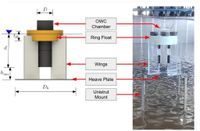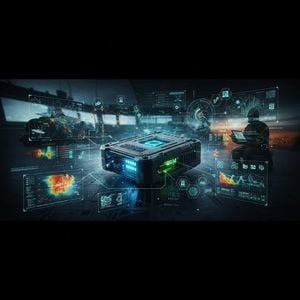As the quest for sustainable energy sources intensifies, wave energy stands out as a promising alternative, particularly in maritime environments. A recent study has explored the performance of oscillating water column (OWC) wave energy converters (WECs) under irregular wave conditions, offering insights that could revolutionize the technology.
The research, attracting attention from the U.S. Department of Energy and several academic institutions, scrutinizes a fixed-geometry OWC that employs a cylindrical chamber mounted on a submerged plate with V-shaped channels. Previous research primarily concentrated on wave energy converters’ activities under regular wave conditions, but the potential of irregular waves remains largely untapped. Irregular waves better represent real ocean conditions, presenting a unique challenge for energy capture.
The study's experiments were conducted in 2022 at Oregon State University’s Directional Wave Basin, utilizing a large-scale model based on data from the Kilo Nalu Nearshore Observatory in Hawaii, where historical ocean wave patterns were analyzed. Notably, the researchers recognized that conventional methods may not accurately capture performance data due to the chaotic nature of irregular waves.
To assess the OWC's power performance, researchers tested various damping values from the power take-off (PTO) systems, which convert the kinetic energy of moving air in the chamber into usable electrical power through turbines. Importantly, the study proposed a novel method: leveraging data from tests in regular wave conditions to approximate the efficiency of the same OWC under more complex, irregular wave conditions.
During their testing, the researchers employed several orifice plates, which play a pivotal role in determining the energy extraction efficiency by modulating airflow within the OWC chamber. By examining the pressure drop across these orifices, scientists aimed to create a reliable relationship between pressure and volumetric flow rate, which is critically important for characterizing the converter's efficiency.
One key finding indicated that the values of the quadratic loss coefficient, which characterizes PTO damping, were consistent across both wave conditions, confirming a broader application of regular wave test results to irregular conditions. "A new method of estimating total power extraction of an OWC in irregular wave conditions was proposed," stated the authors of the article, emphasizing the innovation that links the two methodologies.
The implications are significant for the evolving field of marine energy. For developers constrained by budget and technological capabilities, this method could simplify the design process for WECs. "Using the pressure signal alone can provide a very good approximation to the average extraction efficiency in the time domain," the authors noted, indicating a path forward that does not rely on complex measurements that are often impractical in real-world ocean environments.
Furthermore, the results of this research revealed that capturing efficiency for OWCs in irregular waves was not as sensitive to variations in wave amplitude as initially believed. This suggests that energy output can remain stable despite changing sea conditions, offering more consistent power generation opportunities for at-sea applications. The potential integration of OWCs with existing marine structures enhances their feasibility and cost-effectiveness.
While this study presents a strong argument for the viability of OWCs as reliable sources of marine energy, the authors urge continuous investigation into the technology's scalability. They noted a ten percent uncertainty associated with their proposed estimation method, which underscores the need for further validation through diverse wave conditions and varying design parameters.
Ultimately, the research contributes vital knowledge to the adaptation of WECs for practical energy solutions while fostering an environment for the blue economy's growth. The adoption of OWCs may significantly impact marine industries reliant on sustainable energy production, providing a reliable source of power capable of meeting the demands of various maritime applications.
As the marine energy sector continues to evolve, findings such as those presented in this study will be critical in guiding future designs of wave energy converters, paving the way for broader deployment of technology harnessing the power of our oceans.




